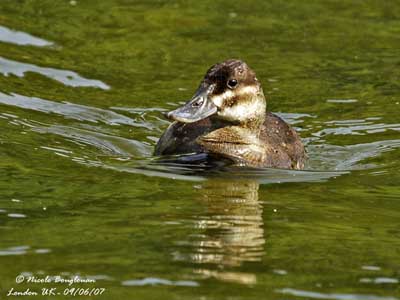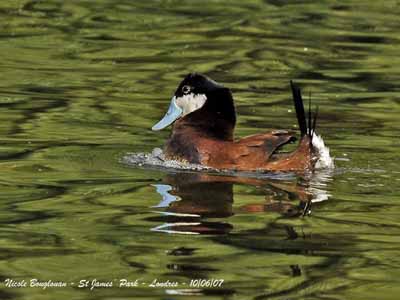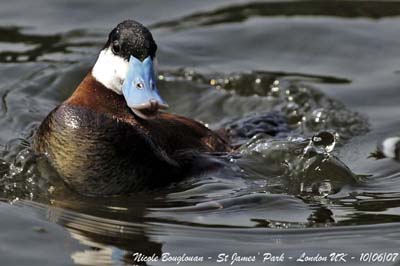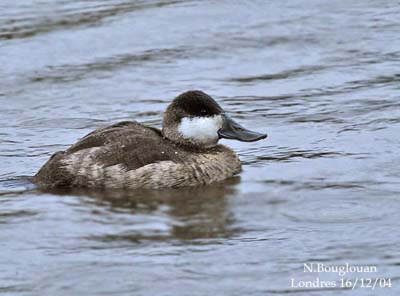
Ruddy Duck – Oxyura jamaicensis
Anseriforme Order – Anatidae Family
BIOMETRICS: Length: 35- 43 cm; Weight: 500-600 g
LONGEVITY: Up to 13 years
DESCRIPTION:
Ruddy Duck is a dumpy diving duck, with typical long tail often cocked, except when diving or swimming.
Adult male in summer plumage has bright chestnut plumage with white cheeks, and black crown and nape. Tail is blackish and rounded. Underparts are chestnut, streaked white on belly. Undertail is white. Underwings are white with dark grey flight feathers. Flattened large blue bill is concave. Eyes are black. Legs and large webbed feet are grey.
Adult male in winter is dull brown chestnut with black cap, white cheeks and greyish chin, neck and nape. Bill becomes greyish.
Adult female in summer is browner than male, slightly washed rufous. Forehead and crown are dark brown. Head is whitish with dark brown stripe crossing the cheek, and fine brown streaks. Bill is dark.
Adult female in winter is darker, greyish brown. Buffy white cheeks show a less distinct dark stripe.
Juvenile resembles adult female in winter with streaked plumage and mottled central underparts. Tail feathers are narrower than in adults.
Ruddy Duck hybridizes with White-headed Duck, producing fertile birds with mixed characters.
VOICE: SOUNDS BY XENO-CANTO
Ruddy Duck is relatively silent. But during courtship displays, it produces noises by slapping its bill against the breast, making some drumming, and creating bubbles around its chest. At this period, male utters continual “chuck-chuck-chuck-chuck-churr”.
HABITAT:
Ruddy Duck breeds in freshwater lakes with fringing vegetation. Outside breeding season, it may also lives in brackish marshes.
RANGE:
This species is native of North America. It breeds across western North America, from NW Territories to Mexico, and locally in Midwest and North East. We can find it in Caribbean, and this species was introduced in Great Britain, and has spread into Europe.
Ruddy Duck winters along the coasts from southern Canada to southern United States, north Central America and Caribbean. In Great Britain, they gather on large open waters and unfrozen lakes and ponds.
BEHAVIOUR:
Ruddy Duck is a diving duck. It has feet situated at the rear of its body, allowing swimming easily under water. It strains the mud with its flattened bill. It forages on the surface and by diving, to get vegetal food.
Ruddy Duck swims with cocked tail, but it may gradually submerge without diving.

If threatened, it dives or hides in dense aquatic vegetation. It is usually nocturnal, and it sleeps during the day with bill among base of the wing, and feet tucked up into flank feathers.
Ruddy Ducks are monogamous and pair bonded for short periods. Territory is based on the nest site.
Courtship display is performed by male in front of female. First, it swims by her with cocked tail in a fan. Then, male rushes over water, swimming rapidly with tail and lower body submerged, but with breast outside water, shoulders forwards, bowed head on the breast. In other display, male slaps rapidly its chest with the bill, before to throw the head forwards while calling.
After mating, male tries to mate with other females. But we can see it some times later swimming with the young of the first female.
Bubbling is used by male both in courtship and defence against other males.

FLIGHT:
Ruddy Duck is a strong flier, but it needs large open space to take off after running over water with rapid wing beats. This species migrates at night in large groups of up to several hundred. During the flight, they have rapid wing beats, and are similar to bumblebees, producing a whirring sound.
REPRODUCTION:
Ruddy Duck’s nest is located in marsh vegetation. Nest is built little by little, adding grasses as the number of eggs increases. Nest may be built on floating vegetation with dry stems, and lined with down. Female builds the nest slightly above water, and anchors it to the shore vegetation.
Female lays one egg a day, and clutch may include 5 to 10 creamy white eggs. She lays some eggs in other nests such as other duck, grebe and rail nests.
Incubation lasts about 22 to 26 days by female. Chicks are precocial and leave the nest within a day after hatching. They can easily swim and dive. Female tends and protects them, but they feed themselves. They fly at about 42 to 49 days of age.
This species produces one brood per year, but two in the southern parts of their range. Nesting occurs from late May to July. Fall migration begins in September, until end of October.
DIET:
Ruddy Duck feeds mainly on vegetal food, seeds and roots, but it also eats larvae of midges, crustaceans and aquatic insects.
PROTECTION / THREATS / STATUS:
Ruddy Duck is an invasive species from North America. Introduced in Great Britain, it escaped from captivity in 1940 and bred in the wild 20 years later. It is now widespread in several European countries, until Spain.

This invasive species interbreeds with the Old World species White-headed Duck, producing fertile hybrids. White-headed Duck is a globally threatened species, and Ruddy Duck chases it away from its range and they compete for nest sites and food.
Several actions to help White-headed Duck to survive have been successful in Spain, with hunting authorizations for Ruddy Ducks in order to reduce their numbers.
Fr: Erismature rousse
All : Schwarzkopf-Ruderente
Esp: Pato Malvasia de Cara Blanca
Ital: Gobbo rugginoso americano
Nd: Rosse Stekelstaart
Russe: Американская савка
Sd: Amerikansk kopparand
Text and pictures by Nicole Bouglouan
Sources:
GUIDE DES CANARDS, DES OIES ET DES CYGNES – de Steve Madge - Delachaux et Niestlé - ISBN: 2603013769
THE HANDBOOK OF BIRD IDENTIFICATION FOR EUROPE AND THE WESTERN PALEARCTIC by Mark Beaman, Steve Madge - C.Helm - ISBN: 0713639601
FIELD GUIDE TO THE BIRDS OF NORTH AMERICA by National Geographic Society - National Geographic Society - ISBN: 0792274512
Animal Diversity Web - (University of Michigan Museum of Zoology)
All About Birds - Cornell Lab of Ornithology
Bird Web (Seattle Audubon Society)
What Bird-The ultimate Bird Guide (Mitchell Waite)
Wikipedia (Wikipedia, The Free Encyclopedia)


